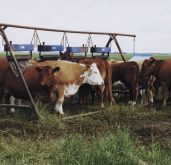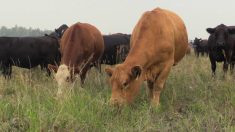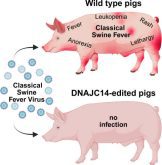Requiring a prescription for antibiotics hasn’t shaken up the beef sector much.
Canada is now several years past the federal regulation change that tightened up how producers could source certain products. According to recent research, cattle producers then and now are using roughly the same amount of antibiotics: very little.
WHY IT MATTERS
Read Also

Linebreeding horses drives genetic bottlenecks
Too much linebreeding and prioritizing pedigree can narrow genetic diversity and lead to horse health problems in future generations.
Cracking down on antimicrobial use in the livestock sector is meant to hold the line on the effectiveness of drugs important for both human and animal health.
Since December 2018, Canadian cattle producers have required a valid veterinary-client-patient relationship and a vet prescription to get antibiotics. Prior to that, certain products were available over the counter.
The recent study out of the Western College of Veterinary Medicine suggests cattle producers are on board with the current rules and have made only minimal changes to their antimicrobial practices.
Most producers were already mindful of antimicrobial resistance risk before the regulations came into play, lead researcher Cheryl Waldner said.
“We compared the data collected in this study to a similar study we had completed in Western Canada in 2014 and only found a few changes in antibiotic use,” she wrote in an email.
“While most cow-calf herds report some antibiotic use, the percentage of animals that are treated in each herd has been low across different studies.”
Studying antibiotic use
To get a pulse on how farmers were using antimicrobials, researchers turned to the Canadian Cow-Calf Surveillance network, made up of herds nationwide, intended to provide a snapshot of Canada’s cow-calf industry.
They surveyed about 150 producers on antimicrobial use both on a herd and animal basis, as well as attitudes towards antimicrobial use and the regulatory changes.
They also collected antimicrobial resistance data from 50 herds in Western Canada. Fecal samples were collected at random from 10 calves and 10 cows in the spring and fall of 2021.
Isolates of E.coli and Enterococcus — a common type of bacteria found in the intestines of many species — were taken and analyzed for resistance. Enterococcus samples were also investigated using whole genome sequencing.
“They are some of the organisms tracked by researchers to understand changes in antibiotic resistance over time,” said Waldner.
Veterinarians were also surveyed to determine attitudes towards antimicrobials, changes in prescribing practices and perspectives on producers’ information needs.
Most surveyed vets said they changed the kind of antibiotics they prescribe. Overall, they decreased prescriptions for sulfonamide antibiotics, in favour of tetracyclines and florfenicol.
Study results
Most cow-calf producers reported using antimicrobials in their herds to treat at least one animal. The frequency of use, however, was relatively low. Most reported treating less than five per cent of their animals.
The primary reasons for treatment included respiratory disease and diarrhea in calves and lameness in adult cows.
A majority of respondents said they were aware of initiatives to improve antimicrobial stewardship. They further identified it as an important issue to both themselves and the beef industry.
Most surveyed said they had not changed how they used the medications, nor did they feel there had been a significant difference in access or cost of the products since regulatory changes took effect. Veterinarians were their primary source of antimicrobial information.

Research did find some evidence of resistance. E.coli resistance was low. Only 16 per cent of isolates were resistant to at least one of the tested antimicrobials. Enterococcus samples, however, found that 85 per cent of isolates were resistant to at least one antimicrobial.
That likely wasn’t related to antimicrobial use, researchers noted. Enterococcus tends to have natural intrinsic resistance to certain medications.
The whole genome sequencing of Enterococcus casseliflavus revealed vanC-type intrinsic genes conveying resistance to vancomycin. That species of Enterococcus has a number of naturally occurring genes that reduce the effectiveness of certain types of antibiotics.
The only observed association between current antimicrobial and resistance was between macrolide use and macrolide resistance for Enterococcus. Macrolides are an antibiotic class used to help control respiratory disease in cattle and manage liver abscesses in feedlots.
On the vet side, most reported that they have more clients requiring prescriptions and now spend more time supporting client needs since the regulatory changes.
Results meet the road
Neil Versavel, a veterinarian with Equi-Tech Veterinary in Stonewall, Man., said beef producers in his areas have been using fewer antibiotics since the regulations were enacted. When they do use them, he said, they’re used more judiciously.
Closer producer-vet relationships have also allowed vets to offer more direction on how growers can use antibiotics more safely and effectively.
“Veterinarians are well-trained and educated in how to best utilize antibiotics and other prescription medications,” said Versavel.
“Producers, I think, benefited from access to that knowledge as far as improving how they treat their animals, and then it also improves our need for judicious use of antibiotics, which is very important in our efforts to combat development of antimicrobial resistance which can have negative effects for both animal and human health.”

If Trevor Atchison, a producer near Pipestone, Man., has one issue with the 2018 regs, it’s occasional inconvenience. For example, he could be some distance away from his official vet. If a family member calls him, saying antibiotics are needed for a sick animal, he can’t just pick some up at the closest vet location.
“From that aspect, it has made it a little more difficult, but it’s been quite manageable,” he said.
He added that he understands the reasoning behind the regulations.
“The system is what it is,” he said.
“And I guess the beef industry is doing our part to follow the rules as to what the ones making decisions are saying is in the best interest for antibiotic use.”
Given that antibiotic use in cattle wasn’t exactly rampant even before the change, Atchison describes the situation as another instance where producers were singled out in the face of a wider problem.
“I’m not sure that we played as big a part in the issues as some thought we did, but that goes hand-in-hand with lots of other things they blame agriculture (and the) beef industry for in the world that aren’t really our fault.”
















